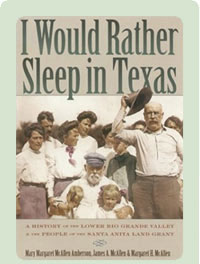I Would Rather Sleep in Texas
My grandmother Margaret H. McAllen conceived a book that could tell the history of the lower Rio Grande Valley through the interpretations left in the written record of Salome Balli and John McAllen, as well as other family members. In 1845, the villas of Spanish colonial settlers on the river that remained relatively isolated experienced a seismic shift when the majority of the United States military arrived in South Texas to establish the American boundary with Mexico at the Rio Grande, rather than the Nueces, which is where the Mexican government felt the line of demarcation should remain. After a little over one hundred years of isolation, the Spanish settlers quickly found their world change in culture, commerce, and connection to the rest of the U.S.
This phenomenon of change further expanded with Texas new statehood and border violence involving regional power-plays and cattle banditry that exploded with Rio Grande standing as the definitive boundary between the two countries. With the advent of the Civil War, when the Confederate States of America quickly found their ports blockaded from shipped goods, and found that South Texas provided the only outlet for cotton, enterprising merchants floated the vital crop across the Rio Grande to Matamoros and other points up and down the lower Rio Grande. This conduit for the Confederates provided them with European goods, clothing, and munitions, then sent northward to the Confederate commands. The merchants in the region profited further as the Imperial army, led by Ferdinand Maximilian of Austria, perpetuated unrest and a trade in northern Mexico.
After the war, the region experienced violence again over valuable cattle herds as ranchers and other impresarios began sending their stock to markets in Kansas. The great trail drives began their treks from ranches in deep South Texas and even northern Mexico. At the Kansas railhead, cattle brought high dollars for the beef desired in the Chicago and New York markets.
Such violence and profit continued through the advent of World War I, the discovery of the Zimmerman Telegram convincing President Woodrow Wilson to see that German threats against America involved violence stemming from the border region on U.S. citizens. This marked the advent of the first systematic protection of the U.S. southern border, and again the lower Rio Grande Valley proved to be a region in which its proximity to the border made interference in American issues a complicated prospect.
This story tells 200 years of South Texas history as witnessed by the women and men of the region, the merchants, the generals, and the bandits, all with their very distinct points of view.



